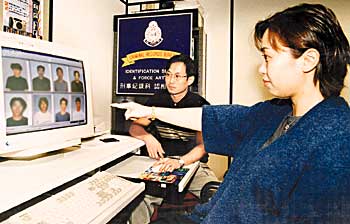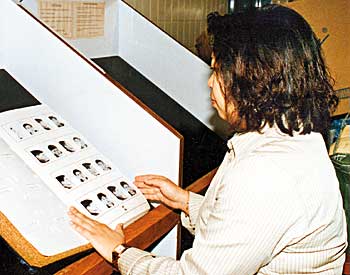Force gains new PAL in criminal fight
Witnesses and victims now have easier and speedier access to suspects' photographs thanks to the recent commissioning of the computerised Photo Album Library (PAL) system.
The move has also greatly enhanced the management and capacity of the mass of suspects' 'mug shots' the Force compiles.
Those wanting to identify a culprit previously had to sift through scores of photo albums categorised mostly by crimes, held in the Criminal Records Bureau in Police Headquarters, and in the Kowloon West and New Territories North Regional Intelligence Units.
 The new: PC Wong Yuen-yau (left) shows how a simple mouse and monitor can speedily lead to an arrest |
The manual system held about 17,000 black and white mug shots but was limited to just 30 albums. Photos more than 10-years-old were weeded out.
Replacing the manual set-up, the photos have now been converted into the PAL system and colour ones can also be added. The computerisation allows investigators to specify the photo images to be shown to witnesses by the offence type, and through a general description of the suspect.
The CRB will soon fit laptop computers with the system also, allowing mug shots to be downloaded for witnesses' viewing in remote locations such as hospitals.
CRB Chief Inspector (Support) Ted Aitken-Davies said each RIU now had a PAL terminal which could be used by all crime formations within the Region, and officers had been trained to conduct viewing sessions. PHQ formations can access the system at the CRB in Arsenal House, West Wing.
"Previously the shots were from the Correctional Services Department and the disadvantage was they were black and white and taken after the person received a prison-standard haircut. But now we are starting to take photos of people as part of our arrest process so they look the same as they probably did in the incident - their general street persona," Mr Aitken-Davies said.
"The way forward is computerisation as it allows you to keep many more people on record with more information and detail. Searching is also very quick as we can be more selective of the photos we show to witnesses and victims. This way, they are not so overwhelmed by such a large number of photos."
 Page flipping: The time-consuming days of old |
He said the system was split into two main areas - the search engine, which contained all the details of each image, and the PAL server which was basically an image library.
"The system then finds the people who fit the criteria loaded in by the officer and witness, and the images are then downloaded, up to eight to a screen," Mr Aitken-Davies said.
"We can get a full download of 300 people to a terminal in minutes and once on the workstation, witnesses just have to page through the images. It is so much faster than the manual system as albums each contained about 800 photo pairs which could take a while to look through."
The new system is available in more locations offering more convenience to witnesses. And having a more reliable index system also saves time in updating files.
The system was formally launched on September 10 after a hand-over ceremony at the CRB, officiated by Assistant Commissioner of Police (Information Systems) Peter Halliday and Assistant Commissioner of Police (Crime) Gordon Fung Siu-yuen.
Mr Fung also presented a commendation to Force Artist Police Constable Wong Yuen-yau who helped develop and manage the new system.
PC Wong was also the brains behind the development of the sketch templates used in the computerised identikit systems, the Artificial Intelligence Crime Analysis System -- Facial Identification Tool.
<< Back to Index >>